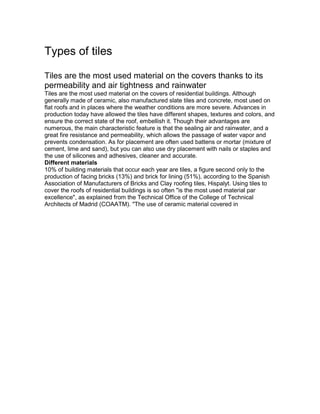
Types of tiles 4
- 1. Types of tiles Tiles are the most used material on the covers thanks to its permeability and air tightness and rainwater Tiles are the most used material on the covers of residential buildings. Although generally made of ceramic, also manufactured slate tiles and concrete, most used on flat roofs and in places where the weather conditions are more severe. Advances in production today have allowed the tiles have different shapes, textures and colors, and ensure the correct state of the roof, embellish it. Though their advantages are numerous, the main characteristic feature is that the sealing air and rainwater, and a great fire resistance and permeability, which allows the passage of water vapor and prevents condensation. As for placement are often used battens or mortar (mixture of cement, lime and sand), but you can also use dry placement with nails or staples and the use of silicones and adhesives, cleaner and accurate. Different materials 10% of building materials that occur each year are tiles, a figure second only to the production of facing bricks (13%) and brick for lining (51%), according to the Spanish Association of Manufacturers of Bricks and Clay roofing tiles, Hispalyt. Using tiles to cover the roofs of residential buildings is so often "is the most used material par excellence", as explained from the Technical Office of the College of Technical Architects of Madrid (COAATM). "The use of ceramic material covered in
- 2. implementing is backed by centuries of experience and tradition.'s The most used material, responding perfectly to the technical and economic requirements. Moreover, its versatility contributes to obtaining various shaped tiles and adding additives such as the application of surface treatments allow to obtain different colors and finishes "from Hispalyt added. Usually the tiles are used to a greater extent, to 'protect' buildings with pitched roof, but this fact depends on the material of which it is composed tile itself. Thus, one can distinguish: • curved tiles, usually ceramic, used for sloping roofs and dormer allow taking advantage as the space below deck. • shingles, slate, ceramic or concrete, widely used for flat roofs. • Tiles ordinary mixed, both ceramic and concrete. • Tiles mixed with a curved profile and flat. Besides this type of shingles, also manufactured parts and accessories to address specific points of the cover: • Tiles ventilation. Occurs facilitate air flow under the tiles and under the cover, and prevent the possible formation of condensation water. • Tiles forward. Beautify the eaves, which extend about 15 inches and prevent moisture and stains occur on the facade. • Sox tiles. Are mixed tiles to which they have been removed the flat. • Double tiles. They are actually mixed tiles, with two sides and a flat curve. • Tiles translucent. Some elements of glass or translucent plastic with an outer shape and a size equal or multiple of the tile, which ensure the passage of light to illuminate the spaces below the roof. "The use of one type or another depends on the area and the temperature. So, in the north are often used over the slate or concrete for strength, while warmer areas are often used ceramic tiles or concrete. With regard to color, there are a variety of shades, which means that, as coating material, beautify their shapes and colors for the roof of a building. Therefore, the tiles may be used as decorative material, Although its primary mission is covering "require from COAATM. Where to put them? Although residential buildings is the most used material in covered sports halls or industrial buildings often replace the shingles for lighter materials and bigger as the roofs of light alloys, zinc or fribrocemento.
